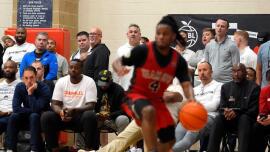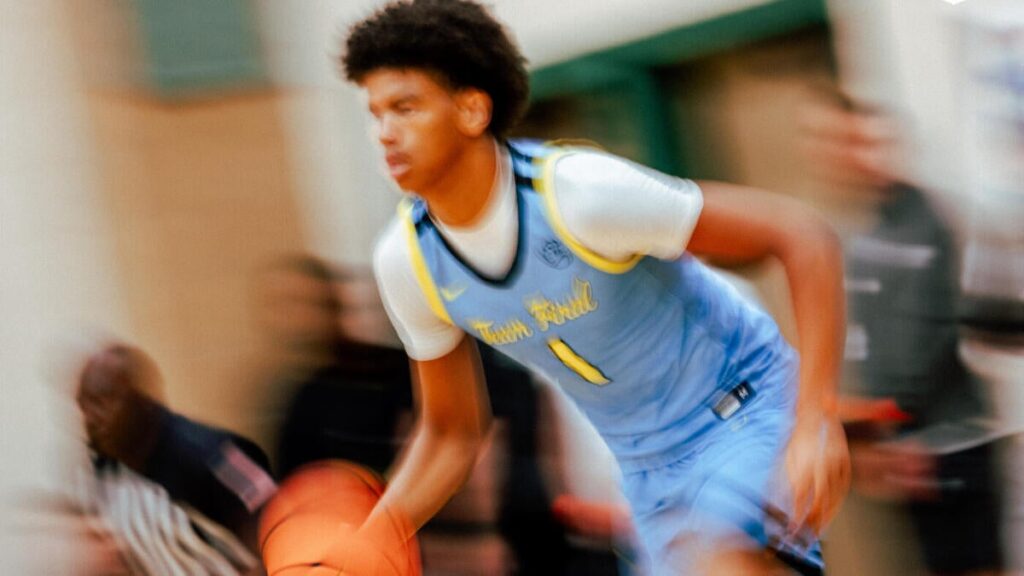NORTH AUGUSTA, S.C. — Nate Hodge has been working in basketball for more than a decade — at the Division I level, at the Division II level and, these days, as Team Final’s coach on the Nike EYBL circuit.
He’s seen the sport from multiple angles.
So, in between games here at Nike’s signature grassroots event, Peach Jam, I asked Hodge if he’d noticed whether transfer waivers, NIL deals and revenue sharing have combined to change how power-conference coaches are recruiting high school prospects this summer.
“Yeah, they’re not,” he said succinctly. “They’re not.”
On a related note, only 11 prospects ranked in the top 115 in the Class of 2026, according to 247Sports, have publicly committed to a program, as of Wednesday morning. Moreover, one power-conference coach recently told me he doubts he’d accept a commitment from any Class of 2026 prospect right now for reasons I’ll explain later. In response to both of these facts, and others, Hodge said his message to his players this year has been a little different than previous messages in previous years.
“I told our kids, from the beginning of the year, in April, when we first started, that with the way the college-recruiting landscape is now for high school kids, you may have to go to a level lower than what you really [could’ve played] at a couple of years ago just so that you can play right away,” Hodge said. “And that’s what all of them are kinda looking at right now.”
How does basketball’s next wave of talent measure up? Summer events forecast a relative downturn
Eric Bossi
Which brings me to Sammy Jackson.
He’s one of the 11 prospects ranked in the top 115 of the Class of 2026 who has already publicly committed to a college. The 6-foot-7 point guard from Philadelphia, a standout for Team Final, generated interest from programs in the SEC, Big Ten, Big 12, ACC and Big East. He visited Indiana last month. He visited Texas the following week. He could’ve committed to a school in any power conference.
“I had SEC, Big Ten, ACC and Big 12 [offers],” Jackson told me. “I had all of them.”
But he passed on all of them and picked an Atlantic 10 program.
Jackson picked VCU.
By the time you’re done with this column, you’ll understand why and wonder whether more prospects ranked where Jackson is ranked — he’s 68th in the Class of 2026, according to 247Sports — should take similar approaches to their recruitments. But before I put it in my words, here’s Jackson, on his decision, in his own words:
“VCU is a school where I know they’re all-in on me. There are a lot of schools out there … SEC, Big Ten, Big 12, ACC … you go in thinking, ‘Are they going to bring in a 25-year-old senior (from the transfer portal) or something like that?’ But I know (at VCU), even if I’m not getting all of the minutes my freshmen year, I know they’re all-in on me. That was the biggest thing for me. The program and the whole staff is all-in on my development. They want me to come in and make an impact immediately.”
This is where college basketball sits these days.
Once upon a time, not too long ago, nearly any power-conference coach would’ve been eager to get an early commitment from the 68th-ranked prospect in a high school class because there’s a chance he could help immediately and, if not, you could just develop him and hope to see an impact in Year 2 or Year 3 because players were way less likely to leave a school after one season before transfer-waivers changed things dramatically. Similarly, once upon a time, not too long ago, nearly any player ranked 68th in his high school class would’ve ended up in a power conference, and possibly in the rotation immediately, because, before transfer-waivers changed things dramatically, power-conference coaches couldn’t just fill roster-holes every Spring with Division I transfers who are, broadly speaking, older and better.
That’s what makes Jackson so interesting. He’s an example of how things have changed.
What Jackson realized through the recruiting process is that, sure, power-conference programs were interested and happy to take him. But literally none of them were willing to commit to him financially this early the way VCU did, in part because most good power-conference programs have accurately realized that, with D1 players now allowed to transfer freely, a solid transfer will likely be better equipped to help immediately than a recent high school-graduate ranked outside of the top 50 in his class.
Put another way, coaches at good power-conference programs are now hesitant to seriously invest in sub-50 high school prospects this early because something more experienced and better will likely be available the moment the transfer portal opens. On the flip side, some sub-50 high school prospects, at least the ones like Jackson, are now hesitant to commit to good power-conference programs this early out of fear of looking up in April and seeing their school of choice sign a 22 year-old mid-major star likely capable of pushing them down the depth chart and putting them at risk of wasting a year of eligibility on the bench.
That’s been happening a lot lately, by the way.
Curious, I went and looked at how the past four prospects ranked No. 68 in their high school classes began their college careers. Each of them picked a power-conference program. None of them played or did much as freshmen.
Here’s the list:
- Kayvaun Mulready was ranked 68th in the Class of 2024. He enrolled at Georgetown and averaged 1.4 points and 0.7 rebounds in 7.9 minutes per game as a freshman.
- Jan Vide was ranked 68th in the Class of 2023. He enrolled at UCLA and averaged 1.9 points and 0.8 rebounds in 7.3 minutes per game as a freshman.
- Jalen Washington was ranked 68th in the Class of 2022. He enrolled at North Carolina and averaged 2.2 points and 1.4 rebounds in 5.6 minutes per game as a freshman.
- Logan Duncomb was ranked 68th in the Class of 2021. He enrolled at Indiana and averaged 0.7 points and 0.7 rebounds in 2.2 minutes per game as a freshman.
Yes, this is a small sample size, but those four players who were ranked in their classes exactly where Jackson is ranked in his class do properly illustrate how challenging it’s become for sub-60 high school prospects to make immediate impacts at good power-conference programs.
As college basketball enters its most uncertain era yet, few believe the new rules will stop the flow of money
Matt Norlander

Can they do it? Sure. But what power-conference coaches now understand is that they’re better off prioritizing transfers to fill roles year-over-year, so that’s what they’re largely doing. And what sub-50 high school prospects should now understand is that schools outside of the traditional power structure are often going to be willing to prioritize them earlier, and be able to offer playing time more quickly, so that’s the direction some of them should be leaning.
Again, Jackson is a great example.
He went through the recruiting process and listened to all of the pitches. With guidance from his family, including his father, former NBA player Marc Jackson, he considered everything before ultimately deciding the wisest thing he could do is began his college career at VCU because it would likely offer the best path to early playing time and, yes, bring the biggest financial return.
According to Marc Jackson, zero power-conference schools offered contracts equal to the contract VCU coach Phil Martelli Jr. put on the table. Only one school was even close, he added.
“[VCU] offered five times the amount of some other schools,” Marc Jackson said. “[VCU] really made Sammy a priority and went far and beyond financially to make sure they showed him that he was a priority.”
Some of this is a byproduct of the House v. NCAA settlement that went into effect July 1 and created what amounts to a salary cap in college athletics and big questions about what will and will not be allowed in NIL going forward. Every Division I athletic department that wants can now spend up to $20.5 million annually directly buying players, but most Power Four institutions are dedicating the overwhelming majority of that money to football, leaving schools that value basketball but don’t have Division I football — like St. John’s, Creighton and, yes, VCU — in advantageous positions.
“VCU has more money to spend than me right now,” one power-conference coach who works at a school that’s made a Final Four told me last week. “They don’t have football. So they have more money than me.”
Asked about this quote, Martelli was measured.
“I can’t speak for the whole conference,” he said. “But I can speak to VCU, and the resources that they put into the program, and the priority that it is. You feel it. I feel it.”
“We have resources,” Martelli added. “We have a commitment.”
It’ll be interesting to follow how all of this unfolds.
Will Jackson prove to be a great investment for VCU and secure Atlantic 10 Freshman of the Year honors while helping the Rams make the 2027 NCAA Tournament? If so, will VCU be capable of keeping him when various power-conference programs undoubtedly circle back with offers in the coming years?
As always, we’ll see.
Either way, it’s neat to watch a young man, with this help of his grassroots coach and family, recognize the changing landscape of college basketball and adjust. For a variety of reasons, what Jackson realized is that it just makes more sense to start his college career at a place where he’s a real priority as opposed to at a place where he might end up at risk of being recruited over once the transfer-portal opens.
It’s an approach Hodge is preaching.
“If you’re not a solidified McDonald’s All-American with a college-ready body, you should probably go to a level lower to play (immediately),” he said. “And then you’ll have more leverage and options after your freshman or sophomore or junior year to go to one of those [power-conference] schools and capitalize on your market.”
Translation: Go star outside of the traditional power-structure early, build value and then field million-dollar offers from power-conference programs once you’re older and established and truly ready for that level.
“Exactly,” Hodge told me when I presented that summary to him. “That’s the way it works now.”
Read the full article here



